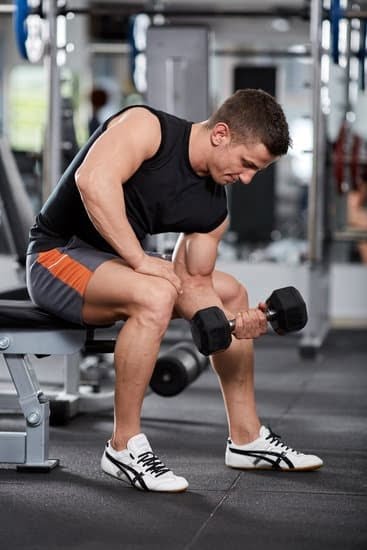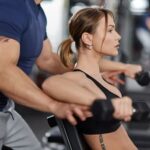How should exercise sneakers fit? Finding the right fit for your exercise sneakers is crucial for both performance and injury prevention. In this article, we will delve into the importance of properly fitting exercise sneakers, common mistakes when choosing them, and how to measure your foot for the right fit.
One of the most important factors to consider when it comes to exercise sneakers is ensuring that they fit properly. Ill-fitting sneakers can lead to discomfort, blisters, and even serious injuries. Whether you are running, cross-training, or walking, having the right fit can make all the difference in your workout routine.
When it comes to finding the perfect exercise sneaker for you, there are a few key factors to consider. From understanding the different types of exercise sneakers available to knowing how to measure your foot for the right fit, we will cover everything you need to know in order to find the best exercise sneaker for your specific needs.
So if you want to improve your athletic performance and prevent injuries, keep reading as we break down all you need to know about finding the perfect-fitting exercise sneaker.
Common Mistakes When Choosing Exercise Sneakers
Choosing the right exercise sneakers is essential for both comfort and performance. However, many people make common mistakes when trying to find the perfect fit. It’s important to understand how exercise sneakers should fit in order to avoid these errors and ensure that you get the most out of your workout.
Here are some of the most common mistakes people make when choosing exercise sneakers:
- Not knowing their correct shoe size: Many individuals have never had their feet measured professionally, and as a result, they may not know their true shoe size. This can lead to wearing exercise sneakers that are too small or too big, causing discomfort and potential injury during physical activity.
- Focusing solely on style: While it’s natural to want exercise sneakers that look good, it’s crucial not to prioritize style over fit. Aesthetics should come second to functionality when it comes to choosing the right footwear for exercise.
- Ignoring specific foot needs: Each person’s feet are different, and what works for one individual may not work for another. Some people have high arches, while others have flat feet, and these differences should be taken into account when selecting exercise sneakers.
Now that you’ve learned about some common mistakes when choosing exercise sneakers, it’s time to explore how exactly your foot should be measured for the right fit.
How to Measure Your Foot for the Right Fit
Properly fitting exercise sneakers are crucial for both comfort and performance during physical activity. Ill-fitting sneakers can lead to discomfort, pain, and even injury, making it essential to find the right fit for your feet. But how should exercise sneakers fit? This section will provide you with a guide on how to measure your foot for the right fit.
To start, it’s important to understand that everyone’s feet are unique, so it’s crucial to measure your own feet rather than relying on standard shoe sizes. Begin by tracing the outline of your foot on a piece of paper while standing up straight. Use a ruler to measure the length from the heel to the longest toe, as well as the width at the widest part.
Once you have these measurements, refer to sizing charts provided by sneaker brands or retailers to determine your correct size. Keep in mind that different brands may have slight variations in sizing, so it’s always best to try on a pair of sneakers before making a purchase if possible.
| Measurement | Length (Inches) | Width (Inches) |
|---|---|---|
| Left Foot | 10 | 5 |
| Right Foot | 2 | 6 |
In addition to length and width, consider any specific characteristics of your feet such as high arches or wide toes that may affect the fit of your exercise sneakers. Ensuring that your sneakers accommodate these unique factors will contribute greatly to finding the perfect fit for you.
Key Factors to Consider When Trying on Exercise Sneakers
When trying on exercise sneakers, there are several key factors to consider to ensure a proper fit and optimal performance. It is important to keep in mind that finding the right exercise sneakers is not just about style, but also about how they feel on your feet and how they support your movements during physical activity.
Comfort and Support
The first thing to consider when trying on exercise sneakers is comfort. Your exercise sneakers should feel snug but not tight, and there should be enough room in the toe box for your toes to wiggle. The sneakers should also provide adequate arch support and cushioning to absorb impact while exercising. Make sure the heel of the sneaker fits snugly against your heel without slipping.
Breathability
Another important factor to consider when trying on exercise sneakers is breathability. Look for sneakers made with breathable materials that allow air to flow in and out of the shoe. This can help prevent sweat from building up and reduce the risk of blisters or discomfort during your workout.
Movement and Flexibility
Lastly, consider how the exercise sneakers move with your foot. When trying them on, take a few steps or even jog in place to see how they feel. The sneakers should allow for natural movement and flexibility without restricting your foot. It is important to find a balance between support and flexibility in order to prevent injuries during physical activity.
By considering these key factors when trying on exercise sneakers, you can ensure a proper fit that will not only enhance your athletic performance but also reduce your risk of injury during exercise.
The Difference Between Running, Cross-Training, and Walking Sneakers
When it comes to choosing the right exercise sneakers, it’s important to understand that different types of workouts require different types of footwear. The difference between running, cross-training, and walking sneakers is crucial in ensuring that you have the proper support and stability for your chosen activity.
Running sneakers are specifically designed to provide cushioning and support for forward motion. They have more cushioning in the heel to absorb impact, as well as a flexible toe area to allow for the natural movement of the foot while running. When trying on running sneakers, be sure to walk around and even jog a bit to ensure they feel comfortable and supportive.
On the other hand, cross-training sneakers are more versatile and are designed to provide stability for activities such as weightlifting, aerobics, and other gym workouts. They have a wider base for better lateral support, as well as additional cushioning in the midsole for shock absorption during high-impact movements. When trying on cross-training sneakers, make sure they feel stable and secure during side-to-side movements.
Lastly, walking sneakers are designed with a more rigid sole for better support during the heel-to-toe motion of walking. They also have a more flexible upper part to accommodate the natural bending of the foot while walking. When trying on walking sneakers, pay attention to how they feel with each step and ensure that they provide enough support without feeling too stiff.
Overall, understanding the difference between these three types of exercise sneakers is essential in finding the right fit for your specific workout needs. By considering these key factors when trying on exercise sneakers, you can ensure that you find the perfect pair to support your fitness goals.
- Running sneakers are designed for forward motion and have extra cushioning in the heel
- Cross-training sneakers provide stability for lateral movements and feature additional cushioning in the midsole
- Walking sneakers have a rigid sole for heel-to-toe motion and a flexible upper part
Tips for Finding the Right Fit for High-Intensity Workouts
When it comes to high-intensity workouts, having the right fit for your exercise sneakers is crucial. The intense and varied movements during activities like HIIT, boot camp classes, or circuit training require a shoe that can provide stability, support, and flexibility. In this section, we will discuss some tips for finding the right fit for high-intensity workouts.
Consider Support and Stability
During high-intensity workouts, your feet will be subjected to rapid directional changes, jumps, and quick sprints. Look for exercise sneakers that offer ample ankle support to prevent rolling or twisting during these movements. Additionally, choose a pair with a wide base and good lateral support to help stabilize your feet during side-to-side movements.
Focus on Flexibility
While stability is important, flexibility is also key when it comes to high-intensity workouts. Your exercise sneakers should allow your feet to move naturally and bend at the ball of the foot to accommodate explosive movements. Look for shoes with a flexible sole that can provide the necessary give without sacrificing support.
Ensure Proper Fit
When trying on exercise sneakers for high-intensity workouts, make sure there is enough room in the toe box while still providing a snug fit throughout the rest of the shoe. Your toes should have enough space to wiggle without feeling cramped or constricted. It’s also essential to consider any existing foot issues or orthotic inserts you may need when determining the right fit for your high-intensity workout sneakers.
By following these tips for finding the right fit in exercise sneakers for high-intensity workouts, you can ensure that your footwear supports you through even the most demanding fitness routines.
The Impact of Poorly Fitting Sneakers on Athletic Performance and Injury Prevention
Properly fitting exercise sneakers are crucial not only for comfort but also for athletic performance and injury prevention. When exercise sneakers fit correctly, they provide the necessary support, stability, and cushioning to help prevent injuries and optimize performance during physical activities. On the other hand, wearing poorly fitting exercise sneakers can lead to discomfort, pain, and a higher risk of injuries such as sprains, strains, and stress fractures.
One of the key factors that contribute to the impact of poorly fitting sneakers on athletic performance is the lack of proper support. When exercise sneakers are too loose or too tight, they fail to provide the necessary support for the feet and ankles during movements such as running, jumping, or lifting weights. This lack of support can result in instability and decreased performance in various athletic activities.
In addition to affecting athletic performance, poorly fitting exercise sneakers can also increase the risk of injuries. Ill-fitting sneakers can cause blisters, calluses, corns, and ingrown toenails due to excessive friction or pressure on certain areas of the feet.
Furthermore, inadequate cushioning and arch support in poorly fitting sneakers can lead to foot pain, heel pain (plantar fasciitis), shin splints, and other overuse injuries. Therefore it is imperative to understand how should exercise sneakers fit for proper foot health and injury prevention.
| Impact Factor | Description |
|---|---|
| Athletic Performance | Poorly fitting sneakers lead to instability and decreased performance |
| Injury Risk | Ill-fitting sneakers increase the risk of blisters, calluses, foot pain, etc. |
The Ultimate Guide to Choosing the Best Exercise Sneakers for Your Feet
In conclusion, finding the right exercise sneakers is essential for optimizing your athletic performance and preventing injuries. Understanding the importance of properly fitting exercise sneakers is the first step in ensuring that you are making the right choice for your feet. By avoiding common mistakes when choosing exercise sneakers and taking the time to measure your foot for the right fit, you can ensure that you are setting yourself up for success in your workouts.
When trying on exercise sneakers, it’s important to consider key factors such as the shape of your foot, the level of support and cushioning needed, and the type of workout you will be doing. Whether it’s running, cross-training, or walking, each type of sneaker serves a different purpose and should be chosen accordingly.
For high-intensity workouts, it’s crucial to find a snug yet comfortable fit to provide stability and prevent any unnecessary movement within the shoe.
Investing in properly fitting exercise sneakers not only impacts athletic performance but also plays a significant role in injury prevention. Wearing poorly fitting sneakers can lead to discomfort, blisters, and even more serious issues such as shin splints or stress fractures.
By following this ultimate guide to choosing the best exercise sneakers for your feet, you’ll be able to confidently select the perfect pair that meets all your needs for comfort, support, and performance enhancement. Remembering how should exercise sneakers fit will ultimately make a difference in your workout experience.
Frequently Asked Questions
How Should Workout Sneakers Fit?
Workout sneakers should fit snugly around the heel and midfoot, with enough room for your toes to wiggle. The toe box should not feel overly tight, and there should be no slipping or rubbing while walking or running.
Should Workout Shoes Be Tight or Loose?
Workout shoes should not be too tight or too loose. They should offer a snug fit around the heel and midfoot to provide support during exercise, without any excessive pressure or discomfort.
How Do I Know if My Workout Shoes Are Too Small?
If your workout shoes are too small, you may experience discomfort, pain, or numbness in your feet. You may also notice blisters or calluses forming, and your toes may feel cramped or restricted inside the shoe.

Passionate about providing useful information to anyone with an interest in the field of Personal Training, I strive to pass on to our readers quality information and to answer any questions about Personal Trainers, the work they do and how to become one.





